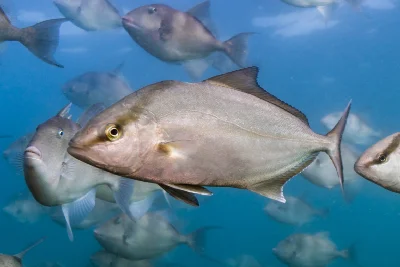Greater Amberjack
Seriola dumerili
The greater amberjack (Seriola dumerili), also referred to as the allied kingfish, great amberfish, greater yellowtail, jenny lind, sea donkey, purplish amberjack, reef donkey, rock salmon, sailor's choice, yellowtail, and yellow trevally, is a prominent species of predatory ray-finned fish within the Carangidae family, which includes jacks and pompanos. This species inhabits temperate, subtropical, and tropical oceans worldwide and holds significant value in both recreational and commercial fisheries. Notably, it is the largest species within its family.
Characterized by its large size, the greater amberjack exhibits a coloration ranging from brownish to bluish-grey on the dorsal side, contrasting with silvery-white underparts. Distinctive markings include a diagonal sooty stripe extending from the snout along the back's center and another dark stripe from the upper jaw across the eye to the front of the first dorsal fin. Occasionally, a light yellow to reddish-brown stripe may appear along the flanks, while the fins are dusky in color. Juvenile fish display clear fins and five vertical bands along their bodies with an additional band on the caudal peduncle. The body is elongated, fusiform, moderately deep, laterally compressed, and covered with small cycloid scales. The maximum recorded length is 190 cm (75 in), though the average is around 100 cm (39 in), and the maximum published weight is 80.6 kg (178 lb), with a reported lifespan of up to 15 years.
The distribution of the greater amberjack is nearly global in the world's subtropical and tropical seas and oceans. In the 🌊 Indian Ocean, its range extends from the African coast through the 🌊 Persian Gulf to Western Australia and southern 🇯🇵 Japan, as far east as the Hawaiian Islands and 🇫🇲 Micronesia in the 🌊 Pacific Ocean, and as far south as Tasmania, 🇦🇺 Australia. In the Western Atlantic Ocean, it ranges from 🇧🇲 Bermuda to as far north as Nova Scotia, extending south to 🇧🇷 Brazil, and includes the 🌊 Gulf of Mexico and the 🌊 Caribbean Sea. In the Eastern Atlantic Ocean, it is occasionally seen as far north as the British Isles and ranges south from the Bay of Biscay to Morocco, encompassing the Mediterranean Sea. It may also occur along the west African coast but is sometimes confused with the similar Seriola carpenteri.
Typically found either as solitary individuals or in small to moderately-sized schools, the greater amberjack displays both epibenthic and pelagic behaviors, commonly associated with reefs, deep offshore caves, drop-offs, rocky outcrops, and deep seaward reefs. Occasionally, it enters coastal bays. Juveniles are often found in open waters, where they find refuge among floating algae, like Sargassum, and debris. It can also inhabit wrecks. Smaller individuals, weighing less than 3 kg (6.6 lb), are often found in shallow waters, while larger fish prefer depths between 18–72 m (59–236 ft) and have been recorded at depths of up to 360 m (1,180 ft).
As adults, greater amberjacks are opportunistic predators, feeding on benthic and pelagic fishes, as well as cephalopods and crustaceans. Their common prey includes species like the bigeye scad (Selar crumenophthalmus) and various sardines (Sardinella aurita and Sardina pilchardus). Juveniles primarily consume plankton, including the larvae of decapods and other small invertebrates, before progressing to larger benthic and nektonic prey as they grow. Upon reaching a length of 8–12 cm (3.1–4.7 in), they transition to hunting larger prey, and upon exceeding 12 cm (4.7 in), they focus on organisms that inhabit or swim near the substrate. Once they reach 20 cm (7.9 in), their diet becomes primarily piscivorous, and they move towards more coastal environments.
Comments
Please, sign in to leave comment
No Comments yet
Last Update: May 28, 2025

